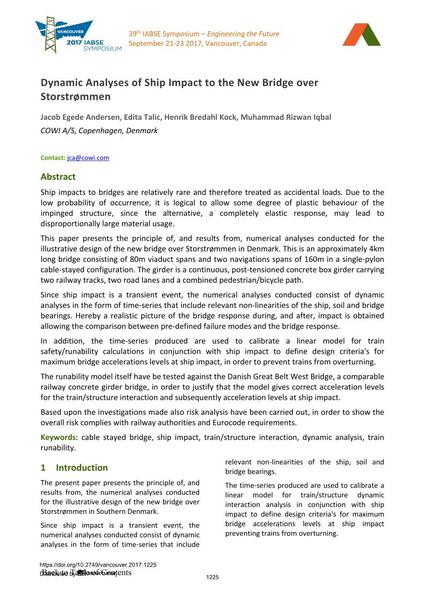Dynamic Analyses of Ship Impact to the New Bridge over Storstrømmen

|
|
|||||||||||
Détails bibliographiques
| Auteur(s): |
Jacob Egede Andersen
(COWI A/S, Copenhagen, Denmark)
Edita Talic (COWI A/S, Copenhagen, Denmark) Henrik Bredah Kock (COWI A/S, Copenhagen, Denmark) Muhammad Rizwa Iqbal (COWI A/S, Copenhagen, Denmark) |
||||
|---|---|---|---|---|---|
| Médium: | papier de conférence | ||||
| Langue(s): | anglais | ||||
| Conférence: | IABSE Symposium: Engineering the Future, Vancouver, Canada, 21-23 September 2017 | ||||
| Publié dans: | IABSE Symposium Vancouver 2017 | ||||
|
|||||
| Page(s): | 1225-1232 | ||||
| Nombre total de pages (du PDF): | 8 | ||||
| Année: | 2017 | ||||
| DOI: | 10.2749/vancouver.2017.1225 | ||||
| Abstrait: |
Ship impacts to bridges are relatively rare and therefore treated as accidental loads. Due to the low probability of occurrence, it is logical to allow some degree of plastic behaviour of the impinged structure, since the alternative, a completely elastic response, may lead to disproportionally large material usage. This paper presents the principle of, and results from, numerical analyses conducted for the illustrative design of the new bridge over Storstrømmen in Denmark. This is an approximately 4km long bridge consisting of 80m viaduct spans and two navigations spans of 160m in a single-pylon cable-stayed configuration. The girder is a continuous, post-tensioned concrete box girder carrying two railway tracks, two road lanes and a combined pedestrian/bicycle path. Since ship impact is a transient event, the numerical analyses conducted consist of dynamic analyses in the form of time-series that include relevant non-linearities of the ship, soil and bridge bearings. Hereby a realistic picture of the bridge response during, and after, impact is obtained allowing the comparison between pre-defined failure modes and the bridge response. In addition, the time-series produced are used to calibrate a linear model for train safety/runability calculations in conjunction with ship impact to define design criteria's for maximum bridge accelerations levels at ship impact, in order to prevent trains from overturning. The runability model itself have be tested against the Danish Great Belt West Bridge, a comparable railway concrete girder bridge, in order to justify that the model gives correct acceleration levels for the train/structure interaction and subsequently acceleration levels at ship impact. Based upon the investigations made also risk analysis have been carried out, in order to show the overall risk complies with railway authorities and Eurocode requirements. |
||||
